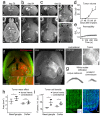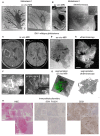Correlated MRI and Ultramicroscopy (MR-UM) of Brain Tumors Reveals Vast Heterogeneity of Tumor Infiltration and Neoangiogenesis in Preclinical Models and Human Disease
- PMID: 30686972
- PMCID: PMC6335617
- DOI: 10.3389/fnins.2018.01004
Correlated MRI and Ultramicroscopy (MR-UM) of Brain Tumors Reveals Vast Heterogeneity of Tumor Infiltration and Neoangiogenesis in Preclinical Models and Human Disease
Abstract
Diffuse tumor infiltration into the adjacent parenchyma is an effective dissemination mechanism of brain tumors. We have previously developed correlated high field magnetic resonance imaging and ultramicroscopy (MR-UM) to study neonangiogenesis in a glioma model. In the present study we used MR-UM to investigate tumor infiltration and neoangiogenesis in a translational approach. We compare infiltration and neoangiogenesis patterns in four brain tumor models and the human disease: whereas the U87MG glioma model resembles brain metastases with an encapsulated growth and extensive neoangiogenesis, S24 experimental gliomas mimic IDH1 wildtype glioblastomas, exhibiting infiltration into the adjacent parenchyma and along white matter tracts to the contralateral hemisphere. MR-UM resolves tumor infiltration and neoangiogenesis longitudinally based on the expression of fluorescent proteins, intravital dyes or endogenous contrasts. Our study demonstrates the huge morphological diversity of brain tumor models regarding their infiltrative and neoangiogenic capacities and further establishes MR-UM as a platform for translational neuroimaging.
Keywords: brain clearing; brain tumor models; glioblastoma; magnetic resonance microscopy; tumor invasion; ultramicroscopy.
Figures




Similar articles
-
Correlated magnetic resonance imaging and ultramicroscopy (MR-UM) is a tool kit to assess the dynamics of glioma angiogenesis.Elife. 2016 Feb 2;5:e11712. doi: 10.7554/eLife.11712. Elife. 2016. PMID: 26830460 Free PMC article.
-
A Cellular Ground Truth to Develop MRI Signatures in Glioma Models by Correlative Light Sheet Microscopy and Atlas-Based Coregistration.J Neurosci. 2023 Jul 26;43(30):5574-5587. doi: 10.1523/JNEUROSCI.1470-22.2023. Epub 2023 Jul 10. J Neurosci. 2023. PMID: 37429718 Free PMC article.
-
Patterns of Invasive Growth in Malignant Gliomas-The Hippocampus Emerges as an Invasion-Spared Brain Region.Neoplasia. 2018 Jul;20(7):643-656. doi: 10.1016/j.neo.2018.04.001. Epub 2018 May 21. Neoplasia. 2018. PMID: 29793116 Free PMC article.
-
Overcoming the blood-brain tumor barrier for effective glioblastoma treatment.Drug Resist Updat. 2015 Mar;19:1-12. doi: 10.1016/j.drup.2015.02.002. Epub 2015 Mar 6. Drug Resist Updat. 2015. PMID: 25791797 Review.
-
Diffusion-weighted MR of the brain: methodology and clinical application.Radiol Med. 2005 Mar;109(3):155-97. Radiol Med. 2005. PMID: 15775887 Review. English, Italian.
Cited by
-
A practical method for multimodal registration and assessment of whole-brain disease burden using PET, MRI, and optical imaging.Sci Rep. 2020 Oct 14;10(1):17324. doi: 10.1038/s41598-020-74459-1. Sci Rep. 2020. PMID: 33057180 Free PMC article.
-
Glioma Cell Migration Dynamics in Brain Tissue Assessed by Multimodal Optical Imaging.Biophys J. 2019 Oct 1;117(7):1179-1188. doi: 10.1016/j.bpj.2019.08.010. Epub 2019 Aug 15. Biophys J. 2019. PMID: 31474305 Free PMC article.
-
Addressing BBB Heterogeneity: A New Paradigm for Drug Delivery to Brain Tumors.Pharmaceutics. 2020 Dec 11;12(12):1205. doi: 10.3390/pharmaceutics12121205. Pharmaceutics. 2020. PMID: 33322488 Free PMC article. Review.
-
Large-scale characterization of the microvascular geometry in development and disease by tissue clearing and quantitative ultramicroscopy.J Cereb Blood Flow Metab. 2021 Jul;41(7):1536-1546. doi: 10.1177/0271678X20961854. Epub 2020 Oct 12. J Cereb Blood Flow Metab. 2021. PMID: 33043767 Free PMC article.
-
Contrast-enhanced ultrasound can differentiate the level of glioma infiltration and correlate it with biological behavior: a study based on local pathology.J Ultrasound. 2025 Mar;28(1):63-74. doi: 10.1007/s40477-024-00961-1. Epub 2024 Nov 4. J Ultrasound. 2025. PMID: 39489864
References
-
- Birner P., Piribauer M., Fischer I., Gatterbauer B., Marosi C., Ambros P. F., et al. . (2003). Vascular patterns in glioblastoma influence clinical outcome and associate with variable expression of angiogenic proteins: evidence for distinct angiogenic subtypes. Brain Pathol. 13, 133–143. 10.1111/j.1750-3639.2003.tb00013.x - DOI - PMC - PubMed
LinkOut - more resources
Full Text Sources
Miscellaneous

